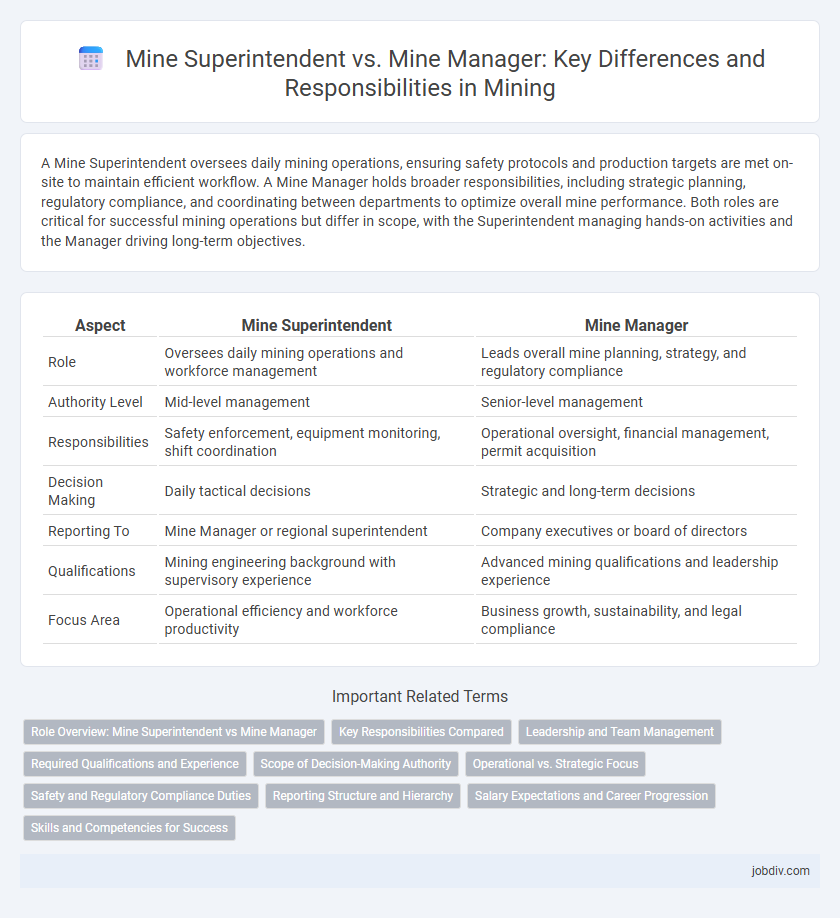A Mine Superintendent oversees daily mining operations, ensuring safety protocols and production targets are met on-site to maintain efficient workflow. A Mine Manager holds broader responsibilities, including strategic planning, regulatory compliance, and coordinating between departments to optimize overall mine performance. Both roles are critical for successful mining operations but differ in scope, with the Superintendent managing hands-on activities and the Manager driving long-term objectives.
Table of Comparison
| Aspect | Mine Superintendent | Mine Manager |
|---|---|---|
| Role | Oversees daily mining operations and workforce management | Leads overall mine planning, strategy, and regulatory compliance |
| Authority Level | Mid-level management | Senior-level management |
| Responsibilities | Safety enforcement, equipment monitoring, shift coordination | Operational oversight, financial management, permit acquisition |
| Decision Making | Daily tactical decisions | Strategic and long-term decisions |
| Reporting To | Mine Manager or regional superintendent | Company executives or board of directors |
| Qualifications | Mining engineering background with supervisory experience | Advanced mining qualifications and leadership experience |
| Focus Area | Operational efficiency and workforce productivity | Business growth, sustainability, and legal compliance |
Role Overview: Mine Superintendent vs Mine Manager
The Mine Superintendent oversees daily mining operations, ensuring compliance with safety regulations and optimizing workflow efficiency. The Mine Manager holds a broader responsibility, including strategic planning, budget management, and overall production targets. Both roles require expertise in mining engineering and leadership, but the superintendent focuses on operational execution while the manager drives long-term organizational objectives.
Key Responsibilities Compared
A Mine Superintendent primarily oversees daily mining operations, ensuring safety compliance, managing on-site equipment, and coordinating workforce activities to optimize productivity. In contrast, a Mine Manager holds broader responsibilities, including strategic planning, budget management, regulatory liaison, and long-term resource allocation to achieve organizational goals. While the Superintendent focuses on operational execution, the Manager integrates operational oversight with corporate objectives and stakeholder communication.
Leadership and Team Management
A Mine Superintendent typically oversees daily operations, ensuring that mining teams adhere to safety protocols and productivity targets through direct leadership and hands-on management. In contrast, a Mine Manager holds broader responsibility, focusing on strategic planning, resource allocation, and long-term team development to drive overall site performance. Effective leadership in mining demands that both roles foster communication, motivate diverse teams, and maintain operational efficiency under challenging conditions.
Required Qualifications and Experience
A Mine Superintendent typically requires a diploma or degree in mining engineering or a related field, with 5 to 10 years of site-specific experience focusing on operational supervision and safety compliance. In contrast, a Mine Manager usually demands advanced qualifications, such as a bachelor's or master's in mining engineering, coupled with 10 to 15 years of comprehensive industry experience including strategic planning, regulatory management, and team leadership. Both roles necessitate strong knowledge in mineral extraction processes, safety regulations, and environmental standards, but the Mine Manager often holds greater responsibility for overall mine profitability and regulatory adherence.
Scope of Decision-Making Authority
The Mine Superintendent typically oversees daily operational decisions related to safety protocols, production schedules, and workforce management within specific mine sections. In contrast, the Mine Manager holds broader decision-making authority encompassing overall mine planning, budgeting, regulatory compliance, and strategic resource allocation across the entire mining operation. This hierarchical distinction ensures that the Mine Manager focuses on long-term goals and risk management while the Superintendent handles immediate operational challenges.
Operational vs. Strategic Focus
Mine Superintendents concentrate on the operational aspects of mining, overseeing daily activities such as drilling, blasting, and workforce management to ensure safety and productivity. Mine Managers adopt a strategic focus, developing long-term plans, managing budgets, and coordinating with stakeholders to align mining operations with business objectives. The distinction lies in the Superintendent's role in tactical execution and the Manager's responsibility for overarching project direction and resource allocation.
Safety and Regulatory Compliance Duties
Mine Superintendents focus primarily on on-site safety enforcement and direct supervision of daily operations to ensure adherence to mining safety protocols and hazard prevention measures. Mine Managers oversee broader regulatory compliance, including implementing company-wide safety policies, coordinating with government regulatory bodies, and ensuring all mining activities meet legal standards. Both roles are critical for maintaining workplace safety and compliance with Mine Safety and Health Administration (MSHA) regulations.
Reporting Structure and Hierarchy
The Mine Superintendent typically reports directly to the Mine Manager, serving as the operational link between the workforce and senior management. While the Mine Manager holds overall responsibility for the mine's strategic direction and compliance, the Superintendent oversees daily production activities and enforces safety protocols. This hierarchical structure ensures effective communication and accountability, with the Mine Manager setting goals and the Superintendent executing operational plans.
Salary Expectations and Career Progression
A Mine Superintendent typically earns an average annual salary ranging from $90,000 to $140,000, reflecting their responsibility for day-to-day operations and crew supervision. In contrast, Mine Managers command higher salaries, often between $120,000 and $180,000, due to their broader oversight of strategic planning, regulatory compliance, and financial management. Career progression from Superintendent to Manager involves accumulating leadership experience, advanced certifications, and proven operational success in large-scale mining projects.
Skills and Competencies for Success
A Mine Superintendent requires strong operational expertise and technical knowledge in mining processes, along with excellent team leadership and safety management skills to ensure efficient day-to-day site activities. A Mine Manager, on the other hand, demands strategic planning abilities, financial acumen, regulatory compliance expertise, and advanced decision-making competencies to oversee overall mine performance and long-term development. Both roles require effective communication, risk management, and problem-solving skills, but the Superintendent focuses more on tactical execution while the Manager emphasizes strategic oversight.
Mine Superintendent vs Mine Manager Infographic

 jobdiv.com
jobdiv.com